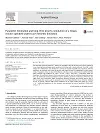The Anaerobic Digestion Model No. 1 (ADM1) was modified to describe the long-term process stability of a two-stage agricultural biogas system operated for 494 days with a mono-substrate. The ADM1 model fraction for carbohydrates was divided into a slowly and readily degradable part. Significant different hydrolysis rate constants were found for proteins and single fractions of carbohydrates in batch experiments. Degradation of starch, xylan (hemicellulose), cellulose and zein (protein) were modeled with first order hydrolysis rate coefficients of 1.20 d−1, 0.70 d−1, 0.18 d−1 and 0.30 d−1, respectively. While the hydrolysis rate coefficients found in batch experiments could be used for predicting continuous process data, the statistically calculated confidence regions (nonlinear parameter estimation) showed that the upper limits were unbounded. Single discrepancies between measured and modeled process data of the two-stage pilot system could be explained by the lack of bioavailability of trace elements. Addition of iron, as Fe(III)Cl3, allowed stable process conditions for an organic loading rate (OLR) up to 2.5 gVS L−1 d−1. Additional supplement of trace elements was necessary for process operation at OLRs above 2.5 gVS L−1 d−1.
